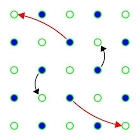 The anti-proximity effect
The anti-proximity effect
Tian et. al. have reported the “anti-proximity effect,” in which superconductivity of a nanowire is suppressed by bulk superconductivity in attached leads. We consider the phase fluctuations of a quantum nanowire and find that in the absence of dissipation (i.e., with superconducting leads), due to the finite extent of the wire, phase slips always destroy the superconductivity, even at zero temperature. Dissipation in the leads stabilizes superconductivity. (Published in Phys Rev. Lett. [pdf]
Image caption: Dissipation reduces instanton disordering inside a nanowire.
 The interplay between spin, charge, and the lattice excitations in the high-Tc superconductors
The interplay between spin, charge, and the lattice excitations in the high-Tc superconductors
We developed a renormalization group scheme that allows the simultaneous study of electron-electron and electron-phonon interactions, and applied it to study the high-temperature superconducting Cuprates. Electron-phonon couplings with x2-y2 anisotropy are driven by magnetic excitations to grow stronger under renormalization group flow. These electron-phonon interactions, mostly involving antinodal excitations, can promote density wave orders. (Published in Europhys. Lett. [pdf])
Image caption: A phonon-mediated scattering process with x2-y2 symmetry that is enhanced by magnetic excitations.


 A symmetry principle leading to featureless Mott insulators?
A symmetry principle leading to featureless Mott insulators?